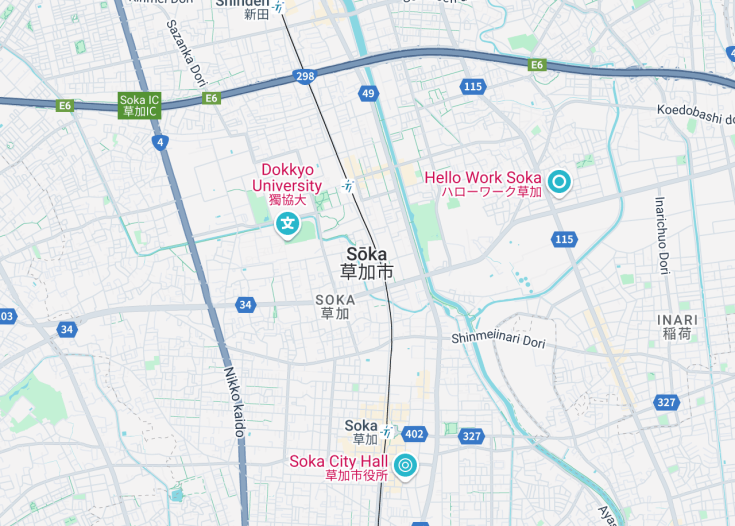Nestled in the heart of Kanto, Soka in Japan is a charming city that boasts a rich tapestry of culture, history, and natural beauty. Known for its scenic river views and vibrant local festivals, Soka offers a tranquil escape from the bustling metropolis of Tokyo. Visitors can explore traditional Japanese gardens, historical temples, and enjoy the famous Soka senbei rice crackers. This hidden gem provides a unique glimpse into the soul of Japanese heritage and rural elegance.
When visiting Soka, make sure to attend the annual Soka Matsuri festival, which showcases traditional dances, music, and local cuisine. It’s an experience that truly captures the spirit of the city.
Plan your trip to Soka during the cherry blossom season to witness the breathtaking sight of blooming sakura along the Ayase River—a perfect setting for picturesque walks and picnics.
Top things to do & see in Soka
Select the following sights and activities to discover best tickets and tours available in Soka.
Explore Enchanting Soka
| Country | Japan |
| Time in Soka | GMT+9 |
| Language spoken | Japanese |
| Population | 247,165 (as of 2021, Source: Japan Statistics Bureau) |
| Currency | Japanese Yen (¥, JPY) |
| Airports |
|
Soka, located in Saitama Prefecture, Japan, is a city known for its rich cultural heritage and its significant history in the development of Japanese society. This city, while embracing modernity, still holds onto traditions such as the famous Soka Matsuri Festival which showcases the culture and arts of Japan.
Where is Soka?
Soka is situated in the southeastern part of Saitama Prefecture, adjacent to Tokyo.
Distances:
| Route | Distance by car | Time by car |
|---|---|---|
| Tokyo to Soka | 15 miles (24 km) | 30 mins |
| Yokohama to Soka | 30 miles (48 km) | 50 mins |
What is Soka famous for?
Soka is renowned for its Soka senbei—delicious, crunchy rice crackers that are a local specialty. The city’s vibrant annual festivals also draw visitors from across Japan and beyond.
History
Prehistoric Times to Feudal Era (Before 1600)
The area now known as Soka first saw inhabitants during the Jomon period, as evidenced by shell mounds and other archaeological finds. It was primarily an agricultural region due to its fertile plains. During the feudal era, Soka was part of the Musashi Province and served as an important location for the production of various goods, contributing to the local economy.
Edo Period (1603-1868)
With the establishment of the Tokugawa Shogunate, Soka became known for its post town along the Nikko Kaido, one of the five routes used to transport goods and daimyo (feudal lords) between important cities. The town thrived as a stopover, facilitating commerce and culture exchange.
Meiji Restoration to World War II (1868-1945)
The Meiji Restoration marked significant changes with modernization efforts impacting Soka. The introduction of the railway system in the late 19th century modernized the area further, enhancing its connectivity with Tokyo and other major cities, which promoted increased economic activity.
Post War Era to Contemporary Times (1945-Present)
Post World War II, Soka embarked on a rapid path of urbanization. Residential areas expanded as people moved from central Tokyo to the suburbs. Today, it is recognized for its vibrant community, cultural festivals, and as a significant residential area in the Saitama Prefecture, fostering a blend of traditional charm and modern convenience.
Visit Soka
What to see and do in Soka, Japan.
Visitors to Soka can explore a variety of attractions and engage in numerous activities. Key sights include the Hyakutaibashi Bridge, offering picturesque views perfect for photography enthusiasts. For those interested in history, the Soka Matsubara, a scenic avenue lined with pine trees, provides a glimpse into the historical travel routes used during the Edo period.
- Visit the Soka City Museum to learn about the city’s rich history and culture.
- Stroll along the Ayase River, especially during the cherry blossom season for breathtaking views.
- Explore local shops and enjoy traditional Japanese sweets like Soka Senbei, a famous local rice cracker.
Festivities in Soka
Soka is home to vibrant cultural events. The Soka Matsuri, held in early October, is a large-scale festival featuring parades, traditional music, and dance performances. The Soka Gakkai International, a significant Buddhist association in the city, also hosts various cultural and peace-promoting events throughout the year.
Best time to visit Soka
The best times to visit Soka are during the spring and autumn seasons. Spring offers the spectacular cherry blossoms along the Ayase River, while autumn brings pleasant weather and colorful foliage, ideal for outdoor activities and festivals.
is Soka worth visiting?
Soka offers a unique blend of historical charm and modern convenience, making it a worthwhile destination for those interested in experiencing a suburban Japanese city close to Tokyo. The cultural festivals and local culinary delights like Soka Senbei appeal to cultural enthusiasts and foodies alike. However, visitors looking for more dynamic nightlife or extensive shopping experiences may find it less appealing. Overall, Soka is best suited for those seeking a quiet retreat with a touch of traditional Japanese lifestyle.









